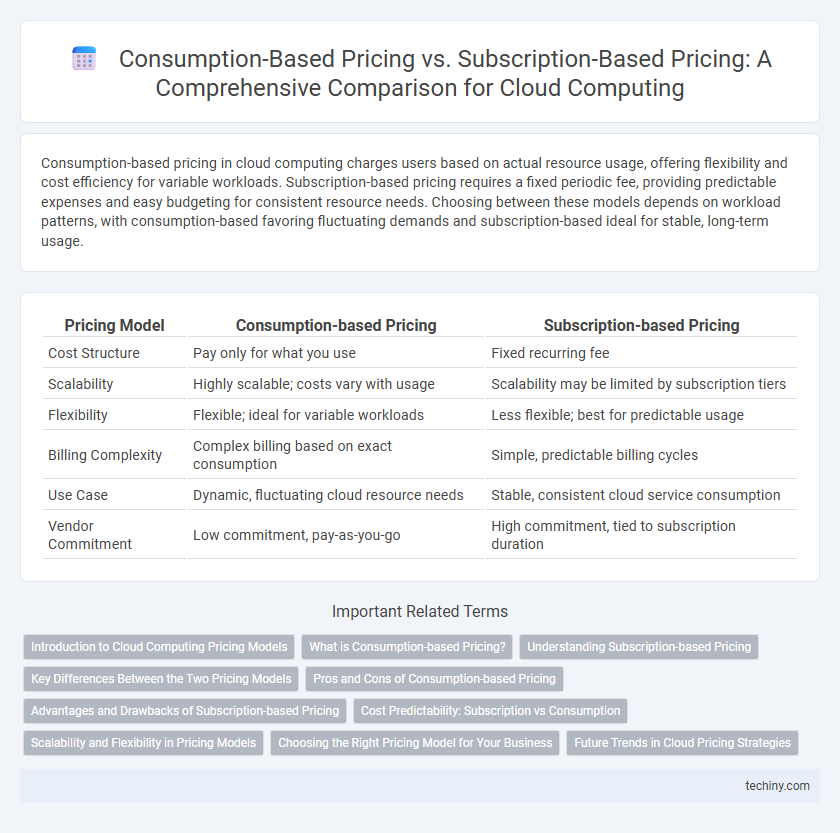Consumption-based pricing in cloud computing charges users based on actual resource usage, offering flexibility and cost efficiency for variable workloads. Subscription-based pricing requires a fixed periodic fee, providing predictable expenses and easy budgeting for consistent resource needs. Choosing between these models depends on workload patterns, with consumption-based favoring fluctuating demands and subscription-based ideal for stable, long-term usage.
Table of Comparison
| Pricing Model | Consumption-based Pricing | Subscription-based Pricing |
|---|---|---|
| Cost Structure | Pay only for what you use | Fixed recurring fee |
| Scalability | Highly scalable; costs vary with usage | Scalability may be limited by subscription tiers |
| Flexibility | Flexible; ideal for variable workloads | Less flexible; best for predictable usage |
| Billing Complexity | Complex billing based on exact consumption | Simple, predictable billing cycles |
| Use Case | Dynamic, fluctuating cloud resource needs | Stable, consistent cloud service consumption |
| Vendor Commitment | Low commitment, pay-as-you-go | High commitment, tied to subscription duration |
Introduction to Cloud Computing Pricing Models
Consumption-based pricing charges users based on actual resource usage, promoting cost efficiency and scalability in cloud computing environments. Subscription-based pricing offers a fixed recurring fee, ensuring predictable expenses and simplified budgeting for organizations. Cloud providers tailor pricing models to meet diverse business needs, balancing flexibility with financial planning.
What is Consumption-based Pricing?
Consumption-based pricing in cloud computing charges users based on their actual resource usage, such as CPU hours, storage capacity, or data transfer, enabling cost efficiency and scalability. This model offers flexibility by allowing businesses to pay only for what they consume, avoiding upfront costs tied to fixed subscriptions. It is ideal for dynamic workloads and unpredictable demand, ensuring optimized operational expenses aligned with real-time consumption patterns.
Understanding Subscription-based Pricing
Subscription-based pricing in cloud computing involves customers paying a fixed fee at regular intervals, typically monthly or annually, ensuring predictable costs and consistent access to services. This model simplifies budgeting for both businesses and providers by offering predefined service packages and usage limits. It is especially beneficial for organizations with steady or predictable workloads requiring continuous cloud resource availability.
Key Differences Between the Two Pricing Models
Consumption-based pricing in cloud computing charges users based on actual resource usage, offering flexibility and cost efficiency for variable workloads. Subscription-based pricing requires a fixed periodic fee, providing predictable costs and easier budgeting for consistent and steady usage. Key differences between these models include billing granularity, cost predictability, and suitability for dynamic versus stable usage patterns.
Pros and Cons of Consumption-based Pricing
Consumption-based pricing in cloud computing offers flexibility and cost efficiency by charging users only for the resources they actually consume, reducing upfront investments and minimizing waste. This model enables scalable usage during peak demand periods but may lead to unpredictable costs and budgeting challenges for businesses with variable workloads. Organizations must carefully monitor consumption patterns to avoid unexpected expenses while benefiting from pay-as-you-go resource allocation and improved financial agility.
Advantages and Drawbacks of Subscription-based Pricing
Subscription-based pricing in cloud computing offers predictable monthly or annual costs, enabling easier budgeting and financial planning for businesses. It ensures consistent access to services and updates, fostering streamlined operations but may lead to overpayment during periods of low usage. However, fixed costs might limit flexibility, making it less cost-effective for organizations with fluctuating or unpredictable cloud resource demands.
Cost Predictability: Subscription vs Consumption
Subscription-based pricing offers predictable monthly or annual costs allowing businesses to budget effectively for cloud services. Consumption-based pricing charges users based on actual resource usage, which can lead to fluctuating expenses and less cost predictability. Choosing subscription models enhances financial forecasting while consumption models provide flexibility for variable workloads.
Scalability and Flexibility in Pricing Models
Consumption-based pricing in cloud computing offers unparalleled scalability and flexibility, allowing businesses to pay only for the resources they actually use, which adapts dynamically to fluctuating workloads and demand spikes. Subscription-based pricing provides predictable costs through fixed monthly or yearly fees, suited for organizations with steady, consistent cloud resource needs but less agility for scaling in real time. Hybrid models increasingly combine these approaches to balance cost control with the agility necessary for variable cloud consumption patterns.
Choosing the Right Pricing Model for Your Business
Choosing the right pricing model in cloud computing depends on your business's usage patterns and financial flexibility. Consumption-based pricing offers scalability by charging only for the resources consumed, ideal for variable workloads and startups seeking cost-efficiency. Subscription-based pricing provides predictable monthly or annual costs, benefiting enterprises with consistent workloads and budget stability requirements.
Future Trends in Cloud Pricing Strategies
Consumption-based pricing in cloud computing promotes cost efficiency by charging users strictly for resources consumed, driving increased adoption of serverless and microservices architectures. Subscription-based pricing offers predictable expenses with bundled services, appealing to enterprises seeking budget stability and comprehensive support. Future trends indicate a hybrid approach combining flexible consumption tiers within subscription models, enhanced by AI-driven usage analytics to optimize costs and service levels dynamically.
Consumption-based Pricing vs Subscription-based Pricing Infographic

 techiny.com
techiny.com